Matthew Dickerson
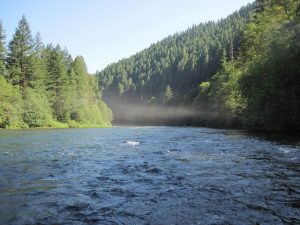 I had a suspicion I would be in for a good day of fishing when, casting a dry fly from the drift boat launch, I landed two rainbow trout before we even got the boat in the water. My friend David O’Hara (Middlebury College ’91) had picked me up at the Portland airport the day before and we’d spent the night camping alongside the McKenzie River in the Willamette National Forest about an hour east of Eugene, Oregon. At first light we’d risen, eaten breakfast, packed lunch and our gear, and dressed for a day of fishing from a drift boat with guide John Gross from the Roaring Fork Guide Service.
I had a suspicion I would be in for a good day of fishing when, casting a dry fly from the drift boat launch, I landed two rainbow trout before we even got the boat in the water. My friend David O’Hara (Middlebury College ’91) had picked me up at the Portland airport the day before and we’d spent the night camping alongside the McKenzie River in the Willamette National Forest about an hour east of Eugene, Oregon. At first light we’d risen, eaten breakfast, packed lunch and our gear, and dressed for a day of fishing from a drift boat with guide John Gross from the Roaring Fork Guide Service.
We met our guide at 7:30am at a boat ramp on the Upper McKenzie in the small town of Blue River. The drift boat was already in the water waiting. The sky was overcast and a cool breeze blew upstream, but it did not feel like rain. Though there were signs of clear cuts on the hillsides, down by the river there were still large patches of the coniferous old growth forest I 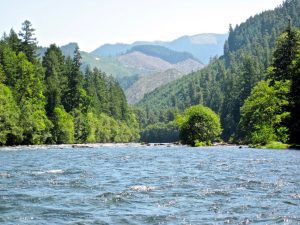 have come to associate with the Pacific northwest. Towering firs and cedars and spruces lined the shores upstream and downstream of our campsite, along with a stand of big-leaf maples. The cedars scented the air with a delightful fresh aroma. The water itself had the gorgeous emerald tint of a river fed by snowmelt. And indeed a glance upriver to the east showed a line of snow covered peaks that trailed southward from Oregon’s Mount Hood.
have come to associate with the Pacific northwest. Towering firs and cedars and spruces lined the shores upstream and downstream of our campsite, along with a stand of big-leaf maples. The cedars scented the air with a delightful fresh aroma. The water itself had the gorgeous emerald tint of a river fed by snowmelt. And indeed a glance upriver to the east showed a line of snow covered peaks that trailed southward from Oregon’s Mount Hood.
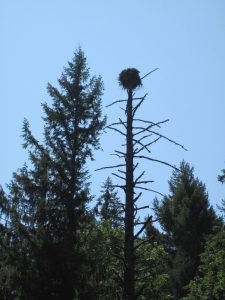 Still, despite the green tint, the snow-fed river was clear and its gravel bottom was visible even where it was eight or ten feet deep. It was beautiful water. It was also water that looked like trout habitat. And while John and Dave portaged the truck and boat trailer downstream eight miles to the takeout point, I was left in charge of the boat. When a fish rose just forty feet off shore at the edge of the swift current, I couldn’t resist pulling out my fly rod and casting for it. I got a couple looks at my fly, but no takes. Too lazy to tie on a different fly, I pulled Dave’s rod out of the boat and took some casts with the fly he had tied on. I quickly landed two fish and lost a third before breaking off his fly in a tree behind me.
Still, despite the green tint, the snow-fed river was clear and its gravel bottom was visible even where it was eight or ten feet deep. It was beautiful water. It was also water that looked like trout habitat. And while John and Dave portaged the truck and boat trailer downstream eight miles to the takeout point, I was left in charge of the boat. When a fish rose just forty feet off shore at the edge of the swift current, I couldn’t resist pulling out my fly rod and casting for it. I got a couple looks at my fly, but no takes. Too lazy to tie on a different fly, I pulled Dave’s rod out of the boat and took some casts with the fly he had tied on. I quickly landed two fish and lost a third before breaking off his fly in a tree behind me.
I was tying a new fly on when Dave and John returned. We pushed the boat into the water and began my first day of guided fishing in Oregon on the McKenzie: a trout salmon, and steelhead river we would soon learn was deserving of its reputation. The first little run we stopped at was no more than a hundred yards downstream of our put-in point where two channels of the braided river came together, John handed us rods he’d already set up with his favorite two-fly rig: a dry fly caddis imitation with a large heavily weighted black nymph trailing off the back. We started getting hits almost at once, and within two minutes we were both playing a fish at the same time.
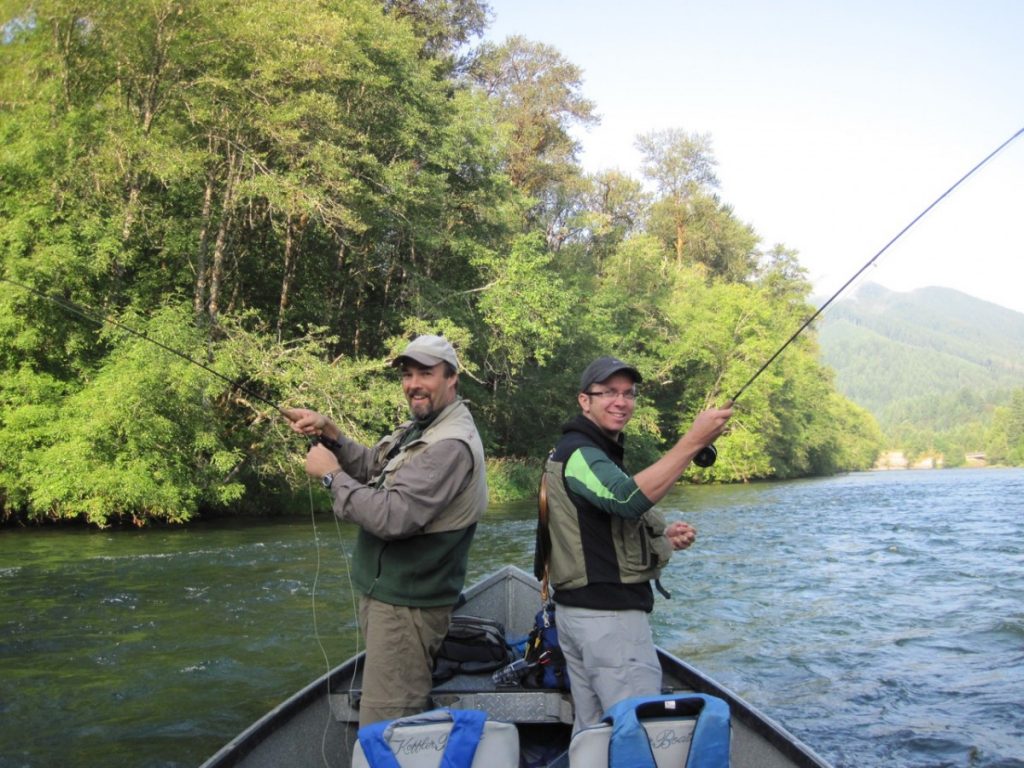
(We had a few that day.)
Double hookups—when we both had a fish on at the same time—would become the norm for the day. Within twenty minutes we had landed a dozen fish on nymphs. When the biting slowed a bit, John pulled anchor and drifted us downstream just thirty yards to the tail end of the confluence. I decided to try to catch fish on one of my own flies. I tied on a small rainbow trout pattern I tied using red chenille from one of my wife’s old sweaters. I landed four fish on it within ten minutes before I broke it off on the mouth of the fifth fish. During the same period, Dave landed five or six more fish. We had not covered more than a quarter mile of our eight mile drift and we had already landed more than twenty wild rainbow trout or rainbow-cutthroat mixes. None of them were behemoths. Most were about 11” to 13” long. A few were a bit longer. But they were fat and healthy and fought well in the cold swift current.
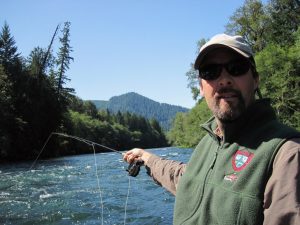 And that pace continued for the next three and a half hours. The fishing did not slow until about 11:30am, by which time our arms were tired from casting and hauling in fish. Admitted, the fishing slowed at midday. Over the next three hours we caught only about a half dozen fish each as we drifted five miles or so of river, ate our bag lunch, and enjoyed the views of the steep bluffs and tall trees that lined the river on both sides providing homes to numerous osprey that spent the day fishing around us.
And that pace continued for the next three and a half hours. The fishing did not slow until about 11:30am, by which time our arms were tired from casting and hauling in fish. Admitted, the fishing slowed at midday. Over the next three hours we caught only about a half dozen fish each as we drifted five miles or so of river, ate our bag lunch, and enjoyed the views of the steep bluffs and tall trees that lined the river on both sides providing homes to numerous osprey that spent the day fishing around us.
But then around 2:30pm the fishing started to pick up. By 3:00pm it was even more intense than it had been in the morning. I was getting fish on dry flies and Dave was now using a three-fly setup. Twice Dave hooked two fish 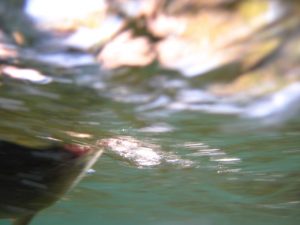 at once, and once was able to land them both. When we finally pulled off the river at 4:30pm, after nine hours of fishing and drifting, John announced that we had landed one hundred and twenty fish. I had stopped counting around fifteen, but I didn’t doubt him. He had spent three decades guiding between Colorado, Oregon and Alaska, and said it was the most fish he had ever seen landed in one day. I can’t verify whether that was really correct. But I do know that—although our campsite was just a few hundred yards from productive water on South Fork of the McKenzie River where it flows out of Cougar Reservoir, and we still had several more hours of daylight left—we did not fish that evening. Even my nearly insatiable appetite for fishing had, for once, been fully satiated.
at once, and once was able to land them both. When we finally pulled off the river at 4:30pm, after nine hours of fishing and drifting, John announced that we had landed one hundred and twenty fish. I had stopped counting around fifteen, but I didn’t doubt him. He had spent three decades guiding between Colorado, Oregon and Alaska, and said it was the most fish he had ever seen landed in one day. I can’t verify whether that was really correct. But I do know that—although our campsite was just a few hundred yards from productive water on South Fork of the McKenzie River where it flows out of Cougar Reservoir, and we still had several more hours of daylight left—we did not fish that evening. Even my nearly insatiable appetite for fishing had, for once, been fully satiated.
